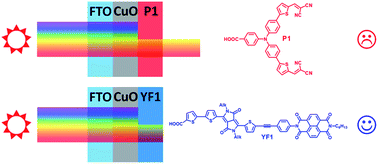CuO nanomaterials for p-type dye-sensitized solar cells†
Abstract
In p-type dye-sensitized solar cells (p-DSSCs), NiO is the most commonly used p-type semiconductor. Nevertheless, because of the drawbacks of NiO, much effort has been made to search for suitable substitutes. Herein, three different morphologies of CuO nanomaterials were used to prepare photocathodes for p-DSSCs, which have a deeper valence band and a higher dielectric constant compared to that of NiO. We observe that CuO is unstable in the presence of iodide/triiodide electrolyte, while cobalt complexes with bipyridine ligands are more suitable redox shuttles. We also note that the average transport time in CuO is shorter than that in NiO. Finally, the deep absorbance of CuO in the visible range indicates that suitable sensitizers for the CuO p-DSSC must exhibit high extinction coefficient and absorption bands located in the lower energy part of the solar spectrum (>600 nm) to be exploitable. In this case such CuO based photocathodes represent valuable systems to exploit the near-infrared (NIR) region.


 Please wait while we load your content...
Please wait while we load your content...